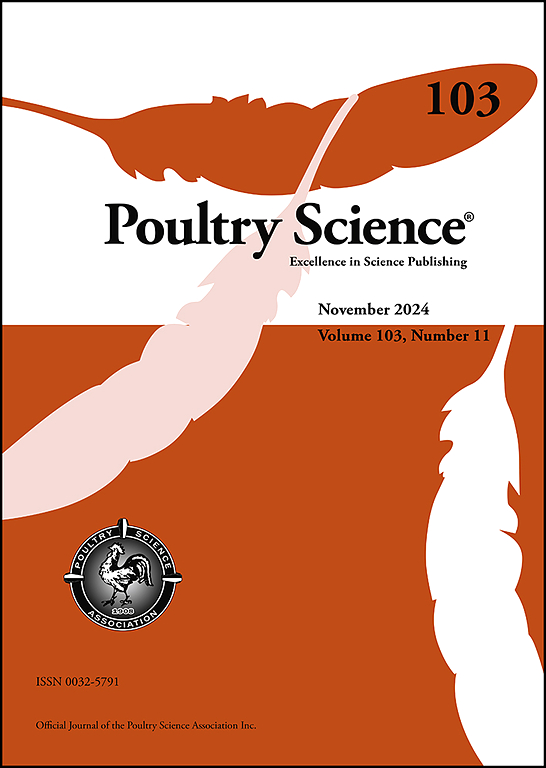41℃通过雷帕霉素激活和线粒体代谢的机制靶点促进鸡肌卫星细胞的增殖
IF 4.2
1区 农林科学
Q1 AGRICULTURE, DAIRY & ANIMAL SCIENCE
引用次数: 0
摘要
鸡肌肉卫星细胞(CMSCs)具有自我更新能力和成肌分化潜能,是养殖肉制品的宝贵细胞资源。提高CMSCs的增殖速率是提高生产效率的关键,而细胞增殖对培养温度的变化高度敏感。一般来说,大多数细胞的标准培养温度为37℃,但这并不能反映鸡的生理体温。在本研究中,我们分别在37、39、41和43°C下培养CMSCs,以确定细胞增殖的最佳温度,并研究细胞在这些条件下的代谢反应。细胞计数和CCK8检测显示,41℃培养的CMSCs的增殖率明显高于其他温度培养的CMSCs。此外,与37°C对照组相比,41°C培养的细胞线粒体功能增强,三磷酸腺苷(ATP)产生增加,同时与雷帕霉素(mTOR)信号通路机制靶基因相关的基因上调。虽然在41°C时活性氧(ROS)的生成增加,但抗氧化酶超氧化物歧化酶1(SOD1)的表达没有明显变化,过氧化氢酶的表达减少。凋亡通路相关因子的表达差异无统计学意义。上述结果表明,41℃是促进CMSCs增殖和线粒体代谢的最佳温度,为优化培养肉制品的培养条件提供了参考。本文章由计算机程序翻译,如有差异,请以英文原文为准。
Forty-one degrees celsius enhances proliferation of chicken muscle satellite cells via mechanistic target of rapamycin activation and mitochondrial metabolism
Chicken muscle satellite cells (CMSCs) possess a self-renewal capacity and myogenic differentiation potential, making them valuable cellular resources for cultured meat production. Enhancing the proliferation rate of CMSCs is essential to improve production efficiency, and cellular proliferation is highly sensitive to changes in the culture temperature. Generally, the standard culture temperature for most cells is 37 °C. however, this does not reflect the physiological body temperature of chickens. In this study, we cultured CMSCs at 37, 39, 41, and 43 °C to determine the optimal temperature for proliferation and investigate the metabolic responses of cells under these conditions. Cell counting and CCK8 assays revealed that CMSCs cultured at 41 °C exhibited a significantly higher proliferation rate than those cultured at other temperatures. Furthermore, compared to the 37 °C control group, cells cultured at 41 °C showed enhanced mitochondrial function and increased adenosine triphosphate (ATP) production, accompanied by the upregulation of genes associated with the mechanistic target of rapamycin (mTOR) signaling pathway. Although reactive oxygen species (ROS) generation was elevated at 41 °C, no significant change in the expression of the antioxidant enzyme superoxide dismutase 1(SOD1) was observed, and the expression of Catalase decreased. Additionally, no significant differences were observed in the expression of apoptotic pathway-related factors. These findings suggest that 41 °C is the optimal temperature for promoting the proliferation and mitochondrial metabolism of CMSCs, providing insights into the optimization of culture conditions for cultured meat production.
求助全文
通过发布文献求助,成功后即可免费获取论文全文。
去求助
来源期刊

Poultry Science
农林科学-奶制品与动物科学
CiteScore
7.60
自引率
15.90%
发文量
0
审稿时长
94 days
期刊介绍:
First self-published in 1921, Poultry Science is an internationally renowned monthly journal, known as the authoritative source for a broad range of poultry information and high-caliber research. The journal plays a pivotal role in the dissemination of preeminent poultry-related knowledge across all disciplines. As of January 2020, Poultry Science will become an Open Access journal with no subscription charges, meaning authors who publish here can make their research immediately, permanently, and freely accessible worldwide while retaining copyright to their work. Papers submitted for publication after October 1, 2019 will be published as Open Access papers.
An international journal, Poultry Science publishes original papers, research notes, symposium papers, and reviews of basic science as applied to poultry. This authoritative source of poultry information is consistently ranked by ISI Impact Factor as one of the top 10 agriculture, dairy and animal science journals to deliver high-caliber research. Currently it is the highest-ranked (by Impact Factor and Eigenfactor) journal dedicated to publishing poultry research. Subject areas include breeding, genetics, education, production, management, environment, health, behavior, welfare, immunology, molecular biology, metabolism, nutrition, physiology, reproduction, processing, and products.
 求助内容:
求助内容: 应助结果提醒方式:
应助结果提醒方式:


